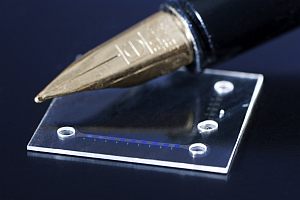Within the framework of a joint project, scientists from KIT and the Technical University of Denmark for the first time succee-ded in producing liquid dye lasers embedded in a 1/3 mm thick foil only and considerably enhancing the power of such lasers.
Optofluidics covers liquid-based optical and photonics elements or components. Optofluidic lasers are miniaturized liquid dye lasers emitting visible light. They may be used as light sources for integra-ted optics or integrated photonic sensor systems. In the course of a cooperation project of the KIT young investigator group headed by Dr.-Ing. Timo Mappes with the group of by Prof. Anders Kristensen from the Technical University of Denmark, KIT’s Ph. D. student Christoph Vannahme has now succeeded for the first time in produ-cing a laser embedded in a foil of 1/3 mm in thickness only, which reaches a much higher power than conventional lasers.
In a process that is easy to transfer to industrial fabrication, laser production starts by providing a foil with a combination of nano- and microstructures. This is accomplished by embossing at increased temperature using a stamp. “By covering this structure with another foil, a microchannel of 1.6 µm in height is obtained. This cor-responds to one fortieth of the diameter of a hair,” explains Timo Mappes. Christoph Vannahme, Ph. D. student at the Institute for Microstructure Technology and Light Technology Institute of KIT continues with describing the process: ”The microchannel is 0.5 mm wide, its bottom is provided with a nanostructure. When passing a liquid dye through this channel and exciting it such that it glows, laser light is generated as a result of the structurization.”
The period of the nanostructure determines the color, the wave-length, of the laser light. Using two different periods, different laser wavelengths can be obtained with the same liquid. The channel design allows for high pulse energies of more than 1 microjoule and small bandwidths of the laser light. As the liquid is pumped through the microchannel, the dye molecules are exchanged constantly and very long service lives are reached.
Within the framework of a stay abroad funded by the Karlsruhe Hou-se of Young Scientists (KHYS), Vannahme worked at the Technical University of Denmark for a period of six months and developed the new laser. The laser can be integrated in microoptical analysis sys-tems that are developed by Vannahme in the course of his Ph. D. thesis. The results have now been published in the Optics Express journal.
KHYS is the communication and interaction platform of all Ph. D. students and young post-docs of KIT. It is a central institution provi-ding counseling and support to all Ph. D. students from the begin-ning of their Ph. D. thesis to its successful completion and further career planning. The KHYS grant for stays abroad is aimed at fun-ding accommodation and living expenses for a stay of three to six months’ duration. This stay abroad is supposed to extend the re-search activities and to provide young scientists with the opportunity to enhance their scientific and intercultural competences and familia-rize with other science systems.
Christoph Vannahme completed his studies of physics with distincti-on at the University of Paderborn. When applying for and accepting the Ph. D. position at KIT, the support of stays abroad by KHYS was one of the decisive factors.
Reference
”Optofluidic dye laser in a foil“, Christoph Vannahme, Mads Brøkner Christiansen, Timo Mappes, Anders Kristensen, (2010), Optics Ex-press 18 (9): 9280-9285, DOI: 10.1364/OE.18.009280.
In close partnership with society, KIT develops solutions for urgent challenges – from climate change, energy transition and sustainable use of natural resources to artificial intelligence, sovereignty and an aging population. As The University in the Helmholtz Association, KIT unites scientific excellence from insight to application-driven research under one roof – and is thus in a unique position to drive this transformation. As a University of Excellence, KIT offers its more than 10,000 employees and 22,800 students outstanding opportunities to shape a sustainable and resilient future. KIT – Science for Impact.

